Decision Making Process: At the start, every day, groups of people, or organizations, may face decisions that can affect results either in a big way or in little ways. From a student deciding which course to take to the manager assigning resources to a new project-decision making is always a way of life and work.
Yet, many decisions fail not necessarily for desire of doing but because there was no clear process to guide them. In the absence of structure, choices tend to rely too much on intuition, resulting in risks and errors and leaving opportunities unpracticed. Thus, importance is attached to the decision making process because it provides a systematic approach for analyzing problems, exploring alternatives, and selecting the best possible solution.
In this article, we will discuss the 6-step decision making process, how it applies to management, and some real-life examples. This could be the guide to equip you with clarity and confidence in making better decisions, whether you’re a novice interested in how decisions are made or a practitioner looking for structured techniques.
What Is Decision Making Process?
The decision-making process involves a step-by-step approach that helps individuals and organizations select the best alternative.
Some salient characteristics are:
- A structured mode of thought, which avoids impulsive or emotional choices.
- Evidence-based, using facts, data, and analysis.
- Goal-oriented, ensuring that choices are made on the basis of objectives.
- Repeatability: Workable at the personal, academic, and professional levels.
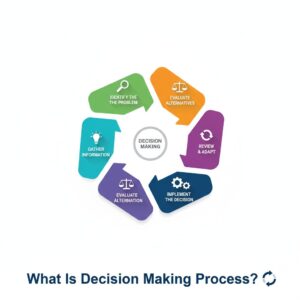
And in management, this process is integral to problem-solving, planning, and strategy execution. Thus, one might commonly find PDFs of the decision-making process in management courses or corporate training.
Also Read: Difference between Data Scientist, Data Engineer, Data Analyst
Why Is the Decision-Making Process Important in Management?
For any organization, the price of a bad decision can be very high-lost profits, squandered resources, or damaged reputation. The decision-making process of management reduces such hazards by making sure that options are:
- Data-based-evidence, not presumptions.
- Collaborative-team members are involved in order to take into account alternative views.
- Transparent-easily understood and documented, holding people accountable.
- Consistent-using an accepted framework across departments.
As an example, before releasing a new product, managers might rely on the decision-making process for management PDF to record all the steps-from defining customer needs to assessing competitor strategies-to ensure alignment across teams with measurable outcomes.
Also Check: Career Opportunities in Data Analytics (Data Analytics Career)
The 6 Steps Of Decision Making Process
Let us now discuss the six steps of decision making in detail, supported by examples for better understanding.
Step 1: Identify the Problem or Opportunity
Every decision starts with some recognition that action is called for. Here, the problem is nicely defined, or an opportunity is spotted.
Example: A software company notices a drop in user engagement. Instead of rushing to add new features, it first defines the problem: “Why are users spending less time on our app?”
The clarity at this stage will help ensure that you’re solving the right problem and not just its symptoms.
Step 2: Gather Information and Data
Once defining the problem, relevant information must be gathered. Reports, surveys, competitor analysis, and customer feedback can all fit in here.
Example: The company conducts user surveys, reviews analytics, and benchmarks competitor apps. Findings reveal users want simpler navigation.
In management of decision making process, and data-driven evidence forms the backbone of informed choices. Many organizations standardize this step in Decisions in Management PDFs for teams.
Step 3: Develop Alternatives
After getting some information, start thinking of potential answers to the problem. Creativity is very important at this step.
Example:
- Redesign the app’s user interface.
- Add video tutorials for guidance.
- Introduce a chatbot for real-time help.
- Decision making process like brainstorming, mind mapping, or SWOT analysis are commonly used to expand options.
Step 4: Evaluate the Alternatives
Not all solutions are equally effective, so the next step is to analyze each alternative in terms of trade-offs: comparing the benefits against the risks, costs, and feasibility.
Example:
- UI redesign → High cost, long-term impact.
- Tutorial → Low cost, medium impact.
- Chatbot → Medium cost; it would improve support but not navigation.
Tools such as decision matrices or cost-benefit analysis are often applied in management scenarios.
Step 5: Choose the Best Solution
After the evaluation process, the most viable solution that would achieve the set objectives is accepted.
Example: The company chooses to simultaneously redesign the interface and add video tutorials. This balances long-term improvement with immediate support.
This phase demands a balancing act between the use of logic and being cognizant of actual constraints such as time, budget, and resources.
Step 6: Implement and Review the Decision
Accurate decisions prove effective only if they are properly executed. Planning, communication, assigning responsibilities, and tracking implementations characterize execution.
Example: The company rolled out the new design in phases, tracked user engagement, and solicited feedback. It was determined that user engagement bloomed with a 30% increase in time spent on the app.
Reviewing results fosters the spirit of continuous learning. In instances when results fall below the set expectations, corrective actions could be instituted.
Also Read: What Is Data-Driven Decision-Making?
Are the 5 Steps of Decision-Making Process Applicable for Quick Decisions?
Yes. The five steps of decision making processes with examples are often used for less consequential, mundane, or quick decisions. It is a shortened version of the six-step model.
Usually, the five steps combine two of the original steps:
- Step1 & 2: Define Problem & Gather Information(reduced to Problem Identification and Research).
- Step 3 & 4: Identify & Select Alternatives(reduced to Generate and Select Solution).
- Step 5: Implement.
- Step 6: Review.
Example: Selection of a new office supply vendor; one that bears low risk.
A manager can identify the problem quickly (the current vendor is too expensive), research three alternatives, select one based upon price/delivery, implement the change and review how much they saved later. This more streamlined approach makes the 5 steps in the decision-making process very effective for operational decisions.
Deep Dive: Crucial Decision Making Process for Improvement
Having a structure is crucial, but the quality of insights within this structure depends on the tools—the decision-making techniques—leaders employ. These techniques add enormous value to the analysis in Steps 3 (Evaluation) and 4 (Selection).
- SWOT Analysis
Application: Widely used in Steps 2 and 3 for information-gathering and alternative evaluations. This enables decision-makers to look at each alternative from not only its own merit, but also in the context of the organization’s internal capabilities and external environment.
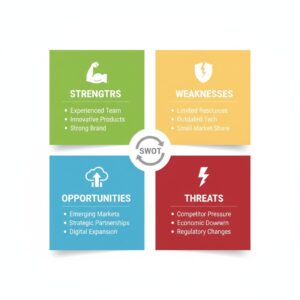
E-E-A-T Principle: An experienced professional knows that an otherwise high-potential opportunity counts for nothing if the internal Weaknesses such as lack of a skilled product execution staff fatally prevent the implementation of the opportunity.
- Cost-Benefit Analysis
Application: This is a quantitative tool, and widely used in Steps 3 and 4. Through a Cost-Benefit Analysis, all the potential costs (financial, time, resources) are weighed against all potential benefits (revenue, efficiency, intangible gains) for one alternative.
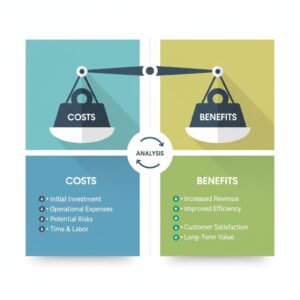
Quantitative Edge: This moves the decision-making process away from gut feeling to a measurable comparison of return on investment.
- Pareto Analysis (The 80/20 Rule)
Application: Most useful in Step 1-Defining the Problem. It states that 80% of the woes come from 20% of the causes.
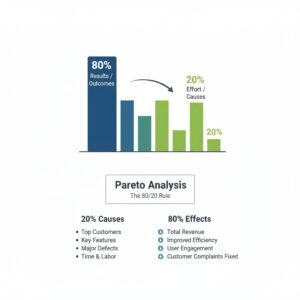
Expertise in Action: When facing hundreds of customer complaints, the skilled decision-maker will utilize Pareto Analysis to identify the 20% of complaints that generate 80% of the volume and thus focus the solution effort in the highest impact areas.
- Decision Matrix Analysis (Pugh Matrix)
Application: A more advanced version of a scoring table, utilized in Steps 3 and 4. It ranks alternatives against a set of weighted criteria and minimizes biases, while ensuring that the final selection is objectively justified.
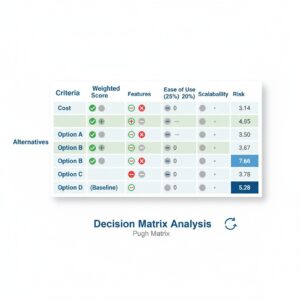
This holds utmost importance for decision making in management, where accountability stands paramount.
The Future of Decision Making Process: AI, Data, and Cognitive Augmentation
The conventional 6-step model still holds as the proper logical framework, though the manner in which steps are achieved is collapsing under rapid change. The future of decision making is quickly becoming characterized through speed enhancement, accuracy improvement, and shift from human-centered to human-AI collaboration.
- Automation and Augmentation: The AI in Decision Making Process
AI is distinctly the greatest disruption since its introduction, particularly in the forms of ML and Generative AI. AI is not aimed at seeking a complete replacement for the human decision maker, but at augmenting human capabilities.
- Real-Time Decentralized Decisions
The high complexity in global operations, together with the pace at which modern markets operate, call for decision making process to be conducted faster and closer to the source of the data.
- Ethical and Governance Challenges
If decision making process become increasingly algorithmic, challenges arise that may well define the management’s strategic focus well into the foreseeable future.
- Shifting Convergence: From Processing to Judgement
In the shifting paradigm, the primary function of the human leaders shall fade away from manual collection of data and analysis of information (tasks delegated to AI) to such higher-level skills and abilities that are rationally and uniquely human.
Path Towards Mastering Decision Making Process
Mastering the decision making process is chiefly associated with being an effective leader. It moves you from being reactive to events to being proactive in determining outcomes. Whether you apply the in-depth six-step model to go through the motions for high-stake strategic choices or you opt for a more condensed five-step version for streamlining day-to-day operations, a strict adherence to a structured process becomes your greatest asset.
The current environment—data-driven and fast-moving—demands a process that is flexible, rigorous, and grounded on continuous learning (Step 6). By adhering to these decision making process and applying potent decision making techniques, you establish Your Expertise and Authoritativeness that translates directly into business success.
Learn Data Analytics with PW Skills
If you wish to apply decision making process to real data, then our Data Analytics Course from PW Skills is best suited for you. Working on hands-on projects, with the assistance of mentorship, and following a structured roadmap, you will learn to convert raw data into meaningful insights. To top it all off, these skills will be highly sought after in many sectors in 2025 and beyond. Get enrolled now and confidently start working on your career.
The 6 steps are: Identify problem, gather information, develop alternatives, evaluate, choose, and implement. For example: a student chooses the right course by doing some research, comparing, and enrolling. 5 steps are scaled back; 7 add details; while 6 are around in even and realistic. The role of decision making in management is to line up the resources, minimize risks, and ensure business growth. Most of the time, managers follow structured frameworks. Most likely downloadable guides for decision making processes can be found in universities, management institutes, and corporate training portals.FAQs
What are the 6 steps of decision-making process with examples?
What is the difference between 5, 6 and 7 steps of decision making?
How does management use decision making?
Where can I get decision making process PDFs?



